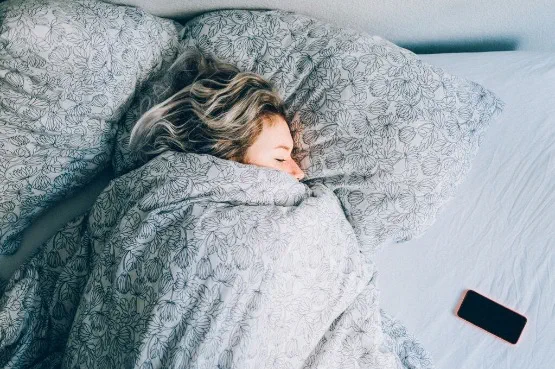Stretches to ease aches and pains
For most of us, modern life isn’t designed with our backs, shoulders, and necks in mind. We might spend many hours sat at a desk, driving, or using devices that strain our upper body. But there’s lots you can do to ease any aches and pains in these areas. Here, we share some simple stretches you can do throughout the day to reduce any discomfort and stiffness.

What causes aches and pains?
Some aches and pains in the back, shoulders and neck arise from injuries or medical conditions. But often they are the result of poor posture, lack of exercise and other lifestyle factors. Many activities in modern life require us to sit in an unnatural position. These include:
- driving
- texting or looking down at your phone
- using a computer and mouse
- watching television
- crafts such as knitting
Similarly, having weak muscles can lead to discomfort, as you need strong muscles to support your body when moving and sitting. Ideally you should combine a strengthening and stretching routine for the best effects.
Five ways to ease a stiff and painful neck
Neck pain and tension is common and can even contribute to headaches in some people.
Here are five ways you can take control of your stiff and painful neck, today.
- Check you have the right set up at your desk. Ensuring your desk and chair are at the right height for your body can help. It’s also important to use eyeglasses if you need them, as straining to look at the computer can create tension in your neck.
- Use ice or heat to ease discomfort. This is particularly useful if you’re suffering from sudden (acute) neck pain or tension. Alternating between hot and cold tends to work best, so you could try ten minutes of ice followed by ten minutes of heat.
- Keep moving. While it’s tempting to rest completely when you have pain, being completely immobile can actually worsen your neck tension and pain. So, try to do some gentle head and neck rolls, or a short yoga class, walk or swim. But avoid sudden, jerking movements that could cause more strain.
- Avoid tech neck. This is when you spend a lot of your time tilting your neck down to look at your phone, tablet, or other device. It can result in repetitive stress to your neck, causing pain. Instead, try to hold your phone or other device at eye level. This will allow you to keep your head in line with the centre of your body.
- Consider massage. Massage may be able to loosen up some of the tightness in your neck, therefore reducing pain. You could see a professional massage therapist, use an at-home massage device or just your own hands. Just be gentle and stop if you feel any discomfort.
Stretches to ease back and shoulder pain
Your shoulders and back can become tight and sore through poor posture, lack of movement and weak muscles. So, staying active, incorporating strength training, and correcting your posture may help. There are also some simple stretches you can add into your routine. The following are four easy stretches to relieve your back tension.
Back stretches
Hello, my name is Liz. Today I’m going to demonstrate four simple back stretches that you can do at home during your lunch break to keep you moving, and reduce the risk of aches and pains. The only equipment you need is your chair!
Having a combination of sitting, standing and moving over the course of your day is key in helping to keep your spine healthy.
- The first stretch is aimed to stretch the neck muscles, in particular a muscle called the upper trapezius, which often gets tight when working at a desk. Holding the chair with your right hand, draw your right shoulder away from the ear. Next flex your head over to the left. To increase the stretch further, place the left hand on the side of the head. Holding for 10-30 seconds, 2-3 times on each side.
- The second stretch focuses on mid back mobility. Sitting down, rotate your upper body around towards the back of the chair. Hold the stretch for 10-30 seconds, inhaling and exhaling as you hold this position. Then, repeat the stretch 2-3 times on each side.
- This next stretch helps to stretch the chest muscles and the large flat muscle across the middle and lower of your back, called latissimus dorsi. Sitting down, reach your arm up towards the ceiling, reach ‘up and over’ to the side. Hold this stretch for 10-30 seconds and return to the middle. Repeat this stretch 2-3 times on each side.
- This final stretch is a forward leaning stretch in standing which helps to open up around the chest muscles and also provides a hamstring stretch. Alongside the other mobility exercises, hamstring stretches can be helpful in the management of lower back pain. Holding the back of the chair, take a few steps backwards keeping your hands in a fixed position. Take three slow breaths as you hold. Next slowly start to bend and straighten your knees three times. Listen to your body and work within your limits here. Repeat this sequence 3-4 times.
You could also try the following exercises to ease back and shoulder pain.
Cat/cow stretches
Starting on all fours, with a flat back:
- slowly inhale as you drop your hips and open your chest
- as you breathe out, arch your spine up land release your head and neck
- alternate between these two moves slowly 5 to 10 times
- you can repeat this during the day to help reduce tension from sitting
Thread the needle
Starting from all fours:
- inhale as you lift your left arm to the ceiling -turning your head to look at your arm
- as you exhale, lower your arm under your body, between your right shoulder and knee
- repeat a few times on each side
Childs pose
Staring from all fours:
- send your hips back towards your heels and stretch your arms out in front of you
- your knees should be the width of a yoga mat
- you can rest your forehead on the floor or use a block or book if it doesn’t reach
- hold for a minute or so before releasing
As well as stretching, try to add some core work into your exercise routine. This can help as a strong core is needed to support your back, and your posture. Adding in some Pilates type moves, or some bodyweight exercises such as planks, may increase your core strength and ease your back pain.
Stretches for sore shoulders
When you have stiff shoulders, it can lead to aches and pains in your neck and back, so it’s a good area to focus on. Shoulder tension may be caused by sitting down for too long, poor posture, or even sleeping in an odd position. Here are some simple stretches you can try.
Shoulder raises
You can do this either sitting or standing
- keeping your arms by your sides, slowly raise your shoulders towards your ears
- hold for a few seconds then release your shoulders back down
- repeat 10 to 15 times
Shoulder rolls
Either standing or sitting:
- roll your shoulders up, back, and down
- when you have done this 10 times, go in the other direction – up, forward and down
Cross arm stretch
- stand up and bring your right arm across the front of your body in a straight line
- use the other hand to hold the arm in place and hold for around 30 seconds
- repeat on the other side
Hopefully these stretches will help to ease your aches and pains. But, if you’re not feeling better after some lifestyle changes, then get in touch with a doctor or physio for further support.
If you have a muscle, bone or joint problem, our direct access service aims to provide you with the advice, support and treatment you need as quickly as possible. If you’re covered by your health insurance, you’ll be able to get advice from a physiotherapist usually without the need for a GP referral. Learn more today.
-
Sources Sources
- Nijs J, Reis F. The Key Role of Lifestyle Factors in Perpetuating Chronic Pain: Towards Precision Pain Medicine. J Clin Med 2022;11(10):2732. doi: 10.3390/jcm11102732
- Al-Hadidi F, Bsisu I, AlRyalat SA, et al. Association between mobile phone use and neck pain in university students: A cross-sectional study using numeric rating scale for evaluation of neck pain. PLoS One 2019;14(5):e0217231. doi: 10.1371/journal.pone.0217231
- Wang R, Yin Y, Zhang H, et al. Risk factors associated with the prevalence of neck and shoulder pain among high school students: a cross-sectional survey in China. BMC Musculoskelet Disord 2023;24(1):641. doi: 10.1186/s12891-023-06656-8
- Owen PJ, Miller CT, Mundell NL, et al. Which specific modes of exercise training are most effective for treating low back pain? Network meta-analysis. Br J Sports Med 2020;54(21):1279-1287. doi: 10.1136/bjsports-2019-100886
- Khazali H, Kroll L, Ashina H, et al. Neck pain and headache: Pathophysiology, treatments, and future direction. Musculoskelet Sci Pract 2023;66. doi: 10.1016/j.msksp.2023.102804
- Lee S, Barros FC, Castro CSM, et al. Effect of an ergonomic intervention involving workstation adjustments on musculoskeletal pain in office workers-a randomized controlled clinical trial. Ind Health 2021;59(2):78-85. doi: 10.2486/indhealth.2020-0188
- Oguzham M, Kaya B, Keskin B, et al. Western massage therapies in the management of neck pain: A systematic review. J Manipulative Physiol Ther 2023;46(1):37-51. doi: 10.1016/j.jmpt.2023.05.003
About our health information
At Bupa we produce a wealth of free health information for you and your family. This is because we believe that trustworthy information is essential in helping you make better decisions about your health and wellbeing.
Our information has been awarded the PIF TICK for trustworthy health information. It also follows the principles of the The Information Standard.

More mental health and wellbeing articles
Did you find our advice helpful?
We’d love to hear what you think. Our short survey takes just a few minutes to complete and helps us to keep improving our healthy lifestyle articles.
Legal disclaimer
This information was published by Bupa's Health Content Team and is based on reputable sources of medical evidence. It has been reviewed by appropriate medical or clinical professionals and deemed accurate on the date of review. Photos are only for illustrative purposes and do not reflect every presentation of a condition.
Any information about a treatment or procedure is generic, and does not necessarily describe that treatment or procedure as delivered by Bupa or its associated providers.
The information contained on this page and in any third party websites referred to on this page is not intended nor implied to be a substitute for professional medical advice nor is it intended to be for medical diagnosis or treatment. Third party websites are not owned or controlled by Bupa and any individual may be able to access and post messages on them. Bupa is not responsible for the content or availability of these third party websites. We do not accept advertising on this page.







